Mezcal
Mezcal (/mɛˈskæl/, Spanish: [mesˈkal] (![]()
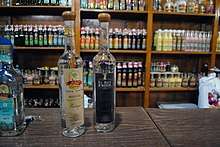
Agaves or magueys are found mainly in many parts of Mexico and south to the equator, though most mezcal is made in Oaxaca.[2] It can also be made in Durango, Guanajuato, Guerrero, San Luis Potosí, Tamaulipas, Zacatecas, Michoacan, and the recently approved Puebla.[3] A saying attributed to Oaxaca regarding the drink is: "Para todo mal, mezcal, y para todo bien, también." ("For everything bad, mezcal, and for everything good, as well.").[4][5]
Whether distilled drinks were produced in Mexico before the Spanish Conquest is unknown.[6] The Spaniards were introduced to native fermented drinks such as pulque, made from the maguey plant. Soon, the conquistadors began experimenting with the agave plant to find a way to make a distillable fermented mash. The result was mezcal.[7]
Today, mezcal is still made from the heart of the agave plant, called the piña, in much the same way as it was 200 years ago.[4][8] In Mexico, mezcal is generally consumed straight and has a strong smoky flavor.[8] Though other types of mezcal are not as popular as tequila (made specifically from the blue agave in select regions of the country), Mexico does export the product, mostly to Japan and the United States, and exports are growing.[9][10]
Despite the similar name, mezcal does not contain mescaline or other psychedelic substances.[11]
History
The agave was one of the most sacred plants in pre-Spanish Mexico, and had a privileged position in religious rituals, mythology and the economy. Cooking of the "piña" or heart of the agave and fermenting its juice was practiced. The origin of this drink has a myth. It is said that a lightning bolt struck an agave plant, cooking and opening it, releasing its juice. For this reason, the liquid is called the "elixir of the gods".[12] However, it is not certain whether the native people of Mexico had any distilled liquors prior to the Spanish Conquest.[6]
Upon introduction, these liquors were called aguardiente (literally “blazing water”). The Spanish had known distillation processes since the eighth century and had been used to drinking hard liquor. They brought a supply with them from Europe, but when this ran out, they began to look for a substitute. They had been introduced to pulque and other drinks based on the agave or agave plant, so they began experimenting to find a way to make a product with a higher alcohol content. The result is mezcal.[7]
Sugarcane and grapes, key ingredients for beverage alcohol, were two of the earliest crops introduced into the New World, but their use as source stocks for distillation was opposed by the Spanish Crown, fearing unrest from producers at home. Still requiring a source of tax revenue, alcohol manufactured from local raw materials such as agave was encouraged instead.[7]
The drinking of alcoholic beverages such as pulque was strongly restricted in the pre-Hispanic period. Taboos against drinking to excess fell away after the conquest, resulting in problems with public drunkenness and disorder. This conflicted with the government's need for the tax revenue generated by sales, leading to long intervals promoting manufacturing and consumption, punctuated by brief periods of severe restrictions and outright prohibition.[7]
Travelers during the colonial period of Mexico frequently mention mezcal, usually with an admonition as to its potency. Alexander von Humboldt mentions it in his Political Treatise on the Kingdom of New Spain (1803), noting that a very strong version of mezcal was being manufactured clandestinely in the districts of Valladolid (Morelia), Mexico State, Durango and Nuevo León. He mistakenly observed that mezcal was obtained by distilling pulque, contributing to its myth and mystique. Spanish authorities, though, treated pulque and mezcal as separate products for regulatory purposes.[7]
Edward S. Curtis described in his seminal work The North American Indian the preparation and consumption of mezcal by the Mescalero Apache Indians: "Another intoxicant, more effective than túlapai, is made from the mescal—not from the sap, according to the Mexican method, but from the cooked plant, which is placed in a heated pit and left until fermentation begins. It is then ground, mixed with water, roots added, and the whole boiled and set aside to complete fermentation. The Indians say its taste is sharp, like whiskey. A small quantity readily produces intoxication."[13] This tradition has recently been revived in the Guadalupe Mountains National Park.[14]
Regulation
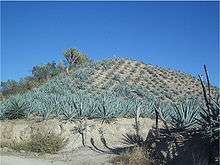
Internationally, mezcal has been recognized as an Appellation of Origin (AO, DO) since 1994.[15][16] There is also a Geographical Indication (GI), originally limited to the states of Oaxaca, Guerrero, Durango, San Luis Potosí, Puebla and Zacatecas. Similar products are made in Jalisco, Guanajuato, Michoacán, and Tamaulipas, but these have not been included in the mezcal DO.[16]
Within Mexico, mezcal is regulated under Norma Oficial Mexicana (NOM) regulations, originally NOM-070-SCFI-1994 (in 1994), by the industry body Consejo Mexicano Regulador de la Calidad del Mezcal A.C. (COMERCAM, the Mexican Regulatory Council for Mezcal Quality). This regulation became law in 2003, and certification began in 2005.[17]
The regulations have been controversial, not only from small artisanal producers for whom the cost of certification is prohibitive, but also from traditional producers outside the chosen GI states. Not only are the latter prohibited from calling their product Mezcal, under the new regulation NOM 199 issued in late 2015, they must label it Komil, a little-known word for intoxicating drink from the Nahuatl language, and must not list the varieties of agave and maguey that are used.[18]
In Canada, products that are labelled, packaged, sold or advertised as Mezcal must be manufactured in Mexico as Mezcal under the stipulated guidelines. However, Canadian laws also allow for local bottling and resale of imported Mezcal, after its alcohol percentage has been adjusted with the addition of distilled or purified water.[19]
Mezcal agave
The agave plant is part of the Agavaceae family, which has almost 200 subspecies.[2] The mezcal agave has very large, thick leaves with points at the ends. When it is mature, it forms a "piña" or heart in the center from which juice is extracted to convert into mezcal. It takes between seven and fifteen years for the plant to mature, depending on the species and whether it is cultivated or wild.[20] Agave fields are a common sight in the semi-desert areas of Oaxaca state and other parts of Mexico.[12]
Varieties
Mezcal is made from over 30 agave species, varieties, and subvarieties, in contrast with tequila, which is made only with blue agave.[3] Of many agave species that can be used to make mezcal, seven are particularly notable.[16] There is no exhaustive list, as the regulations allow any agaves, provided that they are not used as the primary material in other governmental Denominations of Origin.[21] However, the interpretation of this regulation to mean that mezcal cannot be made from blue agave may be a mistranslation.[22] The term silvestre "wild" is sometimes found, but simply means that the agaves are wild (foraged, not cultivated); it is not a separate variety.
Most commonly used is espadín "smallsword" (Agave angustifolia (Haw.), var. espadín),[16] the predominant agave in Oaxaca.[3] The next most important are arroqueño (Agave americana (L.) var. oaxacensis, sub-variety arroqueño),[23] cirial (Agave karwinskii (Zucc.)), barril (Agave rodacantha (Zucc.) var. barril), mexicano (Agave macroacantha or Agave rhodacantha var. mexicano, also called dobadaan)[lower-alpha 1] and cincoañero (Agave canatala Roxb). The most famous wild agave is tobalá (Agave potatorum (Zucc.)).[16][25] Others include madrecuixe, tepeztate, and jabalí. Various other varieties of Agave karwinskii are also used, such as bicuixe and madrecuixe.[24]
Production


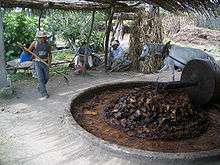
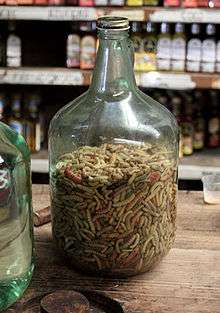
Traditionally, mezcal is handcrafted by small-scale producers.[4] A village can contain dozens of production houses, called fábricas or palenques,[8] each using methods that have been passed down from generation to generation, some using the same techniques practiced 200 years ago.[26] This is an important difference with tequila which is nowadays mostly produced industrially.[27]
The process begins by harvesting the plants, which can weigh 40 kg each, extracting the piña, or heart, by cutting off the plant's leaves and roots.[12] The piñas are then cooked for about three days, often in pit ovens, which are earthen mounds over pits of hot rocks. This underground roasting gives mezcal its intense and distinctive smoky flavor.[5][8] They are then crushed and mashed (traditionally by a stone wheel turned by a horse) and then left to ferment in large vats or barrels with water added.[12]
The mash is allowed to ferment, the resulting liquid collected and distilled in either clay or copper pots which will further modify the flavor of the final product.[8] The distilled product is then bottled and sold. Unaged mezcal is referred to as joven, or young. Some of the distilled product is left to age in barrels between one month and four years, but some can be aged for as long as 12 years.[2][12] Mezcal can reach an alcohol content of 55%.[2] Like tequila, mezcal is distilled twice. The first distillation is known as ordinario, and comes out at around 75 proof (37.5% alcohol by volume). The liquid must then be distilled a second time to raise the alcohol percentage.
Mezcal is highly varied, depending on the species of agave used, the fruits and herbs added during fermentation and the distillation process employed, creating subtypes with names such as de gusano, tobalá, pechuga, blanco, minero, cedrón, de alacran, creme de café and more.[5] A special recipe for a specific mezcal type known as pechuga uses cinnamon, apple, plums, cloves, and other spices that is then distilled through chicken, duck, or turkey breast. It is made when the specific fruits used in the recipe are available, usually during November or December. Other variations flavor the mash with cinnamon, pineapple slices, red bananas, and sugar, each imparting a particular character to the mezcal.[20] Most mezcal, however, is left untouched, allowing the flavors of the agave used to come forward.
Not all bottles of mezcal contain a "worm" (actually the larva of a moth, Hypopta agavis, that can infest agave plants), but if added, it is added during the bottling process.[20] There are conflicting stories as to why such a thing would be added. Some state that it is a marketing ploy.[8] Others state that it is there to prove that the mezcal is fit to drink,[2] and still others state that the larva is there to impart flavor.[12][20]
The two types of mezcal are those made of 100% agave and those mixed with other ingredients, with at least 80% agave. Both types have four categories. White mezcal is clear and hardly aged. Dorado (golden) is not aged but a coloring agent is added. This is more often done with a mixed mezcal. Reposado or añejado (aged) is placed in wood barrels from two to nine months. This can be done with 100% agave or mixed mezcals. Añejo is aged in barrels for a minimum of 12 months. The best of this type are generally aged from 18 months to three years. If the añejo is of 100% agave, it is usually aged for about four years.[2]
Mexico has about 330,000 hectares cultivating agave for mezcal, owned by 9,000 producers.[10] Over 6 million liters are produced in Mexico annually, with more than 150 brand names.[28]
The industry generates about 29,000 jobs directly and indirectly. Certified production amounts to more than 2 million liters; 434,000 liters are exported, generating 21 million dollars in income. To truly be called mezcal, the liquor must come from certain areas. States that have certified mezcal agave growing areas with production facilities are Durango, Guanajuato, Guerrero, Oaxaca, San Luis Potosí, Puebla, Michoacan, Tamaulipas, and Zacatecas. About 30 species of agave are certified for use in the production of mezcal.[10] Oaxaca has 570 of the 625 mezcal production facilities in Mexico,[28] but some in-demand mezcals come from Guerrero, as well.[7] In Tamaulipas, 11 municipalities have received authorization to produce authentic mezcal with the hopes of competing for a piece of both the Mexican national and international markets. The agave used here is agave Americano, agave verde or maguey de la Sierra, which are native to the state.[29]
Drinking
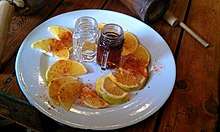
In Mexico, mezcal is generally drunk straight, rather than mixed in a cocktail.[4][8] Mezcal is generally not mixed with any other liquids, but is often accompanied with sliced oranges, lemon or lime sprinkled with a mixture of ground fried larvae, ground chili peppers, and salt called sal de gusano, which literally translates as "worm salt".
In the US, Europe and Japan, mezcal is increasingly becoming a prominent ingredient on many craft cocktail menus. Often mezcal is swapped for a more traditional spirit, in cocktails such as the "Oaxaca Old Fashioned" and the "Mezcal Negroni".
Exportation
In the last decade or so, mezcal, especially from Oaxaca, has been exported.[7] Exportation has been on the increase and government agencies have been helping smaller-scale producers obtain the equipment and techniques needed to produce higher quantities and qualities for export. The National Program of Certification of the Quality of Mezcal certifies places of origin for export products. Mezcal is sold in 27 countries on three continents. The two countries that import the most are the United States and Japan.[10] In the United States, a number of entrepreneurs have teamed up with Mexican producers to sell their products in the country, by promoting its handcrafted quality, as well as the Oaxacan culture strongly associated with it.[8]
Festival
The state of Oaxaca sponsors the International Mezcal Festival every year in the capital city, Oaxaca de Juárez. There, locals and tourists can sample and buy a large variety of mezcals made in the state. Mezcals from other states, such as Guerrero, Guanajuato, and Zacatecas also participate. This festival was started in 1997 to accompany the yearly Guelaguetza festival. In 2009, the festival had over 50,000 visitors, and brought in 4 million pesos to the economy.[30]
See also
- Mexican beer
- Mexican cuisine
- Mexican wine
- Santiago Matatlán
- Snake wine
- Sotol
- Tequila
- Kahlúa
Notes
- Dobadaan is an old colloquial term for mexicano, popularized by Jonathan Barbeiri, founder of Pierde Almas.[24]
References
- What is Mezcal? Elmezcal.org Archived 2012-03-19 at the Wayback Machine
- Lagasse, Erich. "Mezcal: típico afrodisíaco mexicano" [Mezcal:Typical Mexican Afrodisiac] (in Spanish). Univision. Archived from the original on 2010-03-29. Retrieved 2009-10-19.
- "Tequila vs. Mezcal - Mezcal PhD". mezcalphd.com.
- "Oaxaca Mezcal". Go Oaxaca. Archived from the original on 2011-05-19. Retrieved 2011-06-05.
- Galicia, Angelica (2007-09-09). "¡Salud a la mexicana!: el mezcal" [Health, Mexican Style: Mezcal] (in Spanish). Mexico City: Terra. Retrieved 2009-10-19.
- Zizumbo-Villarreal et al. (2009), Distillation in Western Mesoamerica before European Contact, Economic Botany 63(4):413-426.
- De Barrios, Virginia B. (2002). A Guide to Tequila, Mezcal and Pulque. Mexico City: Minutiae Mexicana S.A de C.V. pp. 39–44. ISBN 968-7074-46-9.
- Saltzstein, Dan (2009-04-21). "Hoping Mezcal Can Turn the Worm". New York Times. New York. Retrieved 2009-10-09.
- Archibold, Randal C. (2011-07-21). "Move Over, Tequila, It's Mescal's Turn to Shine", New York Times. Retrieved 2016-03-19.
- "Producción de mezcal genera 29,000 empleos" [Mezcal production generates 29,000 jobs]. El Siglo de Durango (in Spanish). Mezquital, Dgo. 2009-02-23. Archived from the original on 2011-07-22. Retrieved 2009-10-19.
- W.P. Armstrong. "Mescal Bean & The Unrelated Peyote Cactus". Palomar College.
- "Mezcal" [Mezcal] (in Spanish). Oaxaca: Municipality of Oaxaca. Archived from the original on 2009-07-28. Retrieved 2009-10-19.
- Curtis, Edward S (1907). The North American Indian (Vol 1. The Apache. The Jicarillas. The Navaho ed.). p. 28. Retrieved 18 January 2015.
- Mauritson, Martha. "Mescal Roast, an Apache tradition, returning to Guadalupe Mountains". Carlsbad Current-Argus. Archived from the original on 18 January 2015. Retrieved 18 January 2015.
- "Resolution granting Protection of the Appellation of Origin 'Mezcal', to be applied to Alcoholic Beverages of the same Name (MX083)".
- "Modifications to the General Declaration on the Protection of the Appellation of Origin "Mezcal" published in the Official Journal of the Federation on 28 November 1994 (MX082)".
- "What Is Mezcal and Why Is It Happening Now?".
- Agren, David (11 May 2015). "Why trouble is brewing for mezcal's traditional producers". The Guardian. London. p. 19. Retrieved 16 May 2016.
- Minister of Justice, Food and Drug Regulations, retrieved 20 July 2017
- Taibo, Paco Ignacio. "Misterio y magia del mezcal" [Mystery and magic of mezcal] (in Spanish). Mexico City: Mexico Desconocido. Archived from the original on 2010-03-29. Retrieved 2009-10-09.
- McEvoy, John (May 4, 2012). "How Many Agave Varieties Can Be Used To Make Mezcal?". Mezcal PhD. Retrieved 20 April 2020.
- "Dave" (April 8, 2013). "Comment on 'How Many Varieties of Agave Can Be Used to Make Mezcal? (Take 2)'". Mezcal PhD. Retrieved 20 April 2020.
looking at the NOM it specifies: Otras especies de agave, siempre y cuando no sean utilizadas como materia prima para otras bebidas con denominaciones de origen dentro del mismo Estado. (Other species of agave, always and when not used as the principal ingredient for other drinks with denominations of origin *within the same state*.) So from this I would interpret that you could use blue agave under this regulation to make an officially recognized commercial mezcal, just not in one of the states recognized as a producer of tequila (Jalisco, Michoacan, etc).
- "Arroqueño Travels…".
- "Mezcal Marca Negra: Good Things Are Happening".
- "En México existen al menos 7 especies de agave cultivadas y silvestres que son utilizadas para la producción de mezcal. Entre los agaves mezcaleros destacan el “espadín” (Agave angustifolia Haw.), que es el más cultivado y utilizado para la fabricación del mezcal. En orden de importancia le siguen el “arroqueño” (Agave americana L.), el “cirial” (Agave karwinskii Zucc.) y el agave “barril” (Agave rodacantha Zucc.), el “mexicano” (Agave macrocantha) y el maguey “cincoañero” (Agave canatala Roxb). Entre los más famosos y apreciados agaves silvestres por la calidad del mezcal que se obtiene está el “tobala” (Agave potatorum Zucc.)."
- "Buscan llevar su mezcal a todo el mundo" [They seek to bring their mezcal to the whole world]. El Universal (in Spanish). Mexico City. 2009-02-04. Archived from the original on 2009-03-16. Retrieved 2009-10-09.
- "Mezcal vs Tequila: The difference & The History of Tequila and Mezcal".
- Niño de Haro, Humberto (2008-03-13). "Productores de mezcal van tras jóvenes" [Mezcal producers getting younger]. El Universal (in Spanish). Mexico City. Archived from the original on 2013-02-21. Retrieved 2009-10-19.
- "Mezcal tamaulipeco quiere conquistar paladares nacionales" [Mezcal from Tamaulipas wanted to conquer national palates]. El Universal (in Spanish). Mexico City. 2009-08-09. Retrieved 2009-10-09.
- "Inaugura URO XII Feria Internacional del Mezcal" [XII International Festival of Mezcal opens] (in Spanish). Oaxaca: State of Oaxaca. 2009-07-20. Retrieved 2009-10-19.
Further reading
- Bonello, Deborah and Jo Tuckman. "Mezcal: the mystical drink with its own culture and tradition – video". The Guardian. Sunday August 17, 2014.
- Fox Latino: "Mexico's Traditional Spirit Mezcal Takes Over U.S. Bars" - slideshow
External links
| Wikimedia Commons has media related to Mezcal. |
- Mezcal
- Mezcales Tradicionales de los Pueblos de México A NGO which promotes historical practices and customs in the elaboration of Mezcal through informative degustations.
- Mezcal Brands Mezcal brands sold in the United States.
- Best Mezcals as Reported by Ratings Aggregator Proof66
- Mezcal And Agave guide